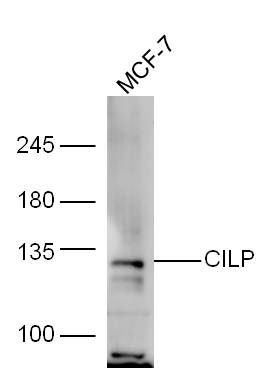产品货号 : mlR13954
英文名称 : CILP
中文名称 : 软骨中间层蛋白CILP抗体
别 名 : Cartilage intermediate layer protein 1 C1; Cartilage intermediate layer protein 1 C2; cartilage intermediate layer protein; cartilage intermediate layer protein, nucleotide pyrophosphohydrolase; Cartilage intermediate-layer protein; CILP 1; CILP; CILP-1; CILP1_HUMAN; HGNC:1980; HsT18872.
研究领域 : 细胞生物 免疫学 信号转导
抗体来源 : Rabbit
克隆类型 : Polyclonal
交叉反应 : Human, Mouse, Rat, Cow, Horse, Sheep,
产品应用 : WB=1:500-2000 ELISA=1:500-1000 IHC-P=1:400-800 IHC-F=1:400-800 ICC=1:100-500 IF=1:100-500 (石蜡切片需做抗原修复)
not yet tested in other applications.
optimal dilutions/concentrations should be determined by the end user.
分 子 量 : 132kDa
细胞定位 : 细胞浆
性 状 : Lyophilized or Liquid
浓 度 : 1mg/ml
免 疫 原 : KLH conjugated synthetic peptide derived from human CILP:1051-1184/1184
亚 型 : IgG
纯化方法 : affinity purified by Protein A
储 存 液 : 0.01M TBS(pH7.4) with 1% BSA, 0.03% Proclin300 and 50% Glycerol.
保存条件 : Store at -20 °C for one year. Avoid repeated freeze/thaw cycles. The lyophilized antibody is stable at room temperature for at least one month and for greater than a year when kept at -20°C. When reconstituted in sterile pH 7.4 0.01M PBS or diluent of antibody the antibody is stable for at least two weeks at 2-4 °C.
PubMed : PubMed
产品介绍 : Major alterations in the composition of the cartilage extracellular matrix occur in joint disease, such as osteoarthrosis. This gene encodes the cartilage intermediate layer protein (CILP), which increases in early osteoarthrosis cartilage. The encoded protein was thought to encode a protein precursor for two different proteins; an N-terminal CILP and a C-terminal homolog of NTPPHase, however, later studies identified no nucleotide pyrophosphatase phosphodiesterase (NPP) activity. The full-length and the N-terminal domain of this protein was shown to function as an IGF-1 antagonist. An allelic variant of this gene has been associated with lumbar disc disease. [provided by RefSeq, Sep 2010]
Function:
Probably plays a role in cartilage scaffolding. May act by antagonizing TGF-beta1 (TGFB1) and IGF1 functions. Has the ability to suppress IGF1-induced proliferation and sulfated proteoglycan synthesis, and inhibits ligand-induced IGF1R autophosphorylation. May inhibit TGFB1-mediated induction of cartilage matrix genes via its interaction with TGFB1. Overexpression may lead to impair chondrocyte growth and matrix repair and indirectly promote inorganic pyrophosphate (PPi) supersaturation in aging and osteoarthritis cartilage.
Subcellular Location:
Secreted > extracellular space > extracellular matrix.
Tissue Specificity:
Specifically expressed in cartilage. Localizes in the intermediates layer of articular cartilage but neither in the superficial nor in the deepest regions. Specifically and highly expressed in intervertebral disk tissue. Expression increases with aging in hip articular cartilage. Overexpressed in articular hyaline cartilage from patients with calcium pyrophosphate dihydrate crystal deposition disease (CPPD). Expression in intervertebral disk tissue from individuals with lumbar disk disease increases as disk degeneration progresses.
Post-translational modifications:
Cleaved into 2 chains possibly by a furin-like protease upon or preceding secretion.
DISEASE:
Defects in CILP are a cause of susceptibility to intervertebral disk disease (IDD) [MIM:603932]. A common musculo-skeletal disorder caused by degeneration of intervertebral disks of the lumbar spine. It results in low-back pain and unilateral leg pain. Note=Susceptibility to intervertebral disk disease, is conferred by variant p.Ile395Thr (PubMed:15864306).
Similarity:
Contains 1 Ig-like C2-type (immunoglobulin-like) domain.
Contains 1 TSP type-1 domain.
SWISS:
O75339
Gene ID:
8483
Important Note:
This product as supplied is intended for research use only, not for use in human, therapeutic or diagnostic applications.
产品图片












